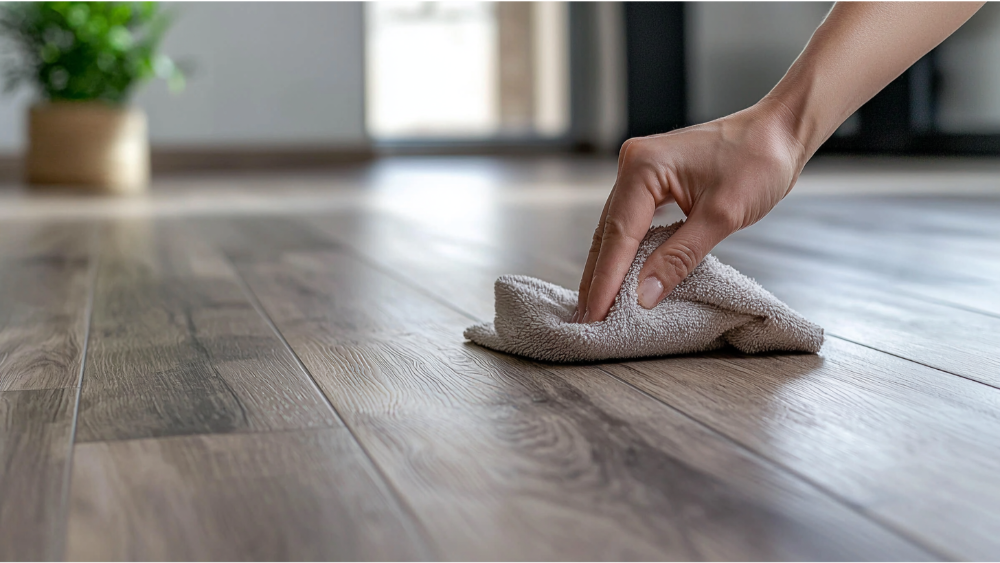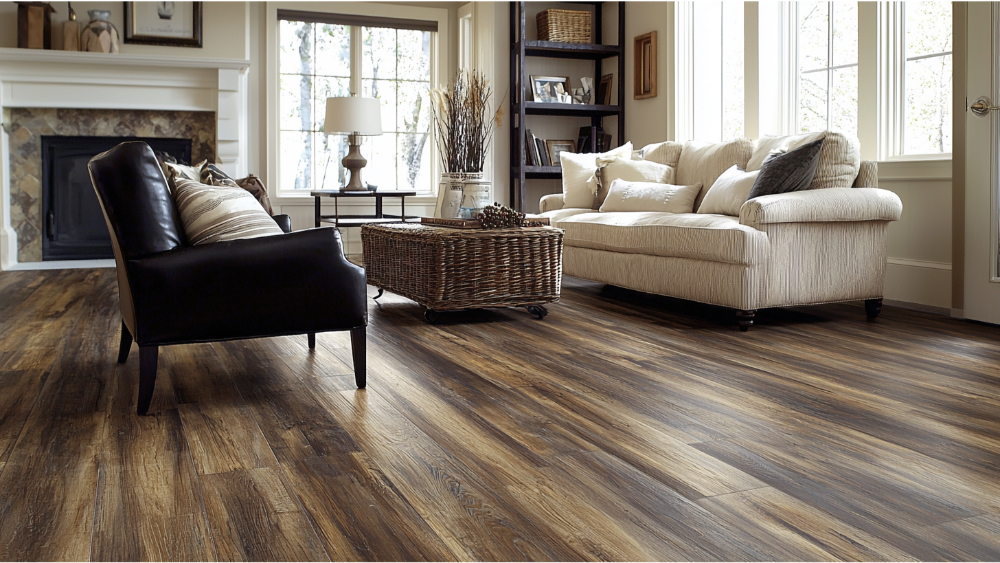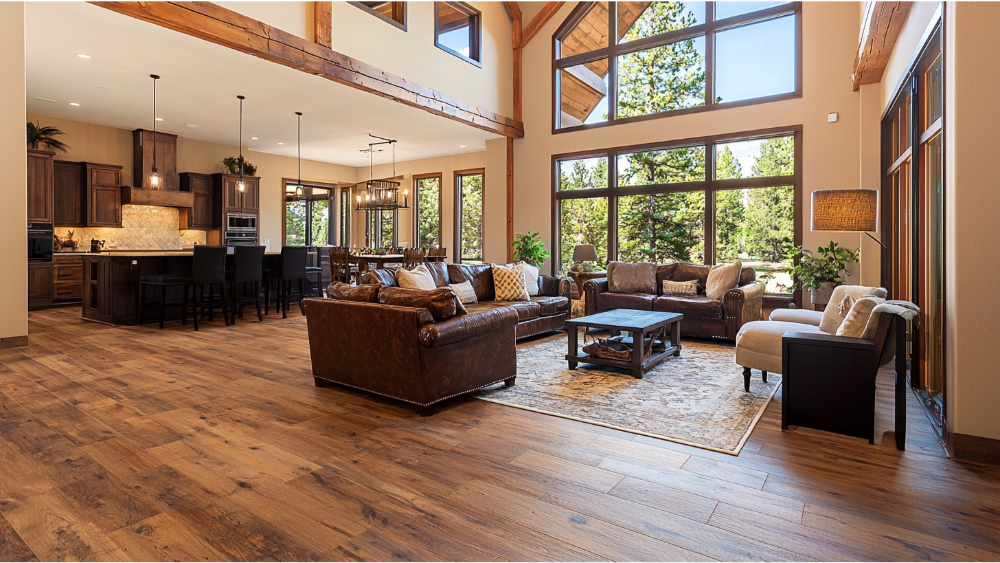Why Proper LVP Cleaning Matters
Luxury vinyl plank flooring is one of the most popular flooring choices for homeowners today, and for good reason. Known for its affordability, water resistance, and the high-end look of real wood, vinyl plank flooring offers both style and functionality. However, to keep your luxury vinyl flooring looking its best for years to come, a consistent and proper cleaning process is essential.
Cleaning is not just about aesthetics, it’s about preserving the structural integrity of your floors. Loose dirt, moisture buildup, and incorrect cleaning products can all lead to premature wear, dullness, or even permanent damage. The following tips will help you understand how to maintain the beauty of your luxury vinyl plank flooring and avoid costly repairs in the future.
Daily & Weekly LVP Cleaning Routine

Step 1 – Sweep or Vacuum to Remove Loose Dirt
One of the most important steps in the cleaning process is to remove loose dirt before it has the chance to scratch the surface of your vinyl plank. Dirt, dust, and tiny debris act like sandpaper, wearing down the protective layer of your LVP floor over time.
Use a soft-bristle broom or a vacuum designed specifically for hard flooring. Avoid using a vacuum with a beater bar, as it may scuff or damage the vinyl surface. Sweeping or vacuuming your vinyl plank flooring daily helps keep dirt from becoming a long-term problem.
Step 2 – Damp Mop Using a Vinyl-Safe Cleaner
After you remove dirt and dust, it’s time to follow up with a damp mop. A microfiber mop head is ideal for picking up any fine particles left behind. Fill a mop bucket with clean water and add one cup of a mild cleaning solution designed for vinyl floors. Avoid overly wet mops, too much water is a bad idea and can lead to standing water in seams, which may cause warping over time.
Gently pass the damp mop across the floor in smooth, even strokes. Rinse the mop head regularly and replace the water if it becomes cloudy. When cleaning vinyl plank flooring, it’s always best to use non-abrasive, pH-neutral floor cleaner solutions that won’t harm the wear layer.
Step 3 – Spot Clean Spills Immediately
Vinyl flooring is water-resistant, but that doesn’t mean it’s waterproof. Letting spills sit for too long is a bad idea. Standing water, especially if left in an affected area, can find its way into seams and edges, potentially causing warping or lifting of the vinyl plank.
When spills occur, wipe them up quickly with a soft cloth or paper towel. Then, use a damp mop with hot water or a small amount of cleaning solution to finish cleaning the area. This quick action will help remove dirt and prevent stubborn stains from forming.
What Cleaners Are Safe for LVP?
Approved Floor Cleaner Solutions
For your LVP floor to stay in great condition, you need to use the right type of cleaner. The best floor cleaners for vinyl are those made specifically for luxury vinyl flooring. These cleaners are non-abrasive, pH-balanced, and gentle enough to clean without breaking down the wear layer.
Many mild cleaners, such as diluted dish soap or branded vinyl floor cleaners like Bona or Zep, are excellent choices. A simple mix of clean water and one cup of white vinegar can also be effective for regular maintenance, though it should not be used frequently as vinegar is acidic and could dull the shine over time.
Avoid These Abrasive Cleaners and Tools
Certain cleaning agents and tools may seem effective but can actually cause more harm than good. Products that contain ammonia, bleach, wax, or any oil-based solvents are not suitable for vinyl plank flooring. These substances can strip the finish, leave residue, or discolor the surface.
Avoid abrasive cleaners, steel wool, scouring pads, and anything designed to “scrub.” Also, never use a steam mop—the intense heat and moisture can cause the adhesive under the planks to break down, leading to separation or warping. Stick with gentle methods and vinyl-specific materials to avoid permanent damage.
How to Remove Stains and Scuffs from LVP Flooring

Removing Scuff Marks from Vinyl Plank
Scuff marks are common in high-traffic areas where shoes or furniture have contact with the floor. To clean scuff marks, start with a microfiber cloth or a clean tennis ball and rub the affected area gently. If the mark is stubborn, apply a small amount of baking soda mixed with water to form a paste. Rub with a soft cloth, then rinse and wipe dry with clean water.
Dealing with Stubborn Stains on Luxury Vinyl
If you encounter stubborn stains from ink, dye, or grease, act quickly. Dab the affected area with rubbing alcohol on a soft cloth, and wipe the spot gently. Do not scrub hard. Afterward, rinse with clean water and wipe the area dry.
For food spills or pet messes, use mild cleaners that are enzyme-based, and always mop afterward with clean, hot water to remove any remaining residue. The key is to avoid using anything that will grind dirt into the surface or break down the vinyl finish.
Preventative Care Tips to Keep Vinyl Flooring Looking New

Use Floor Mats and Protective Rugs
One of the easiest ways to protect your vinyl plank is by placing floor mats at every entry point. These mats will help trap dirt and moisture before they ever reach your LVP floor. Use rugs with a breathable, latex-free backing to prevent staining or moisture buildup underneath.
In areas prone to spills, such as under kitchen sinks or around pet dishes, consider adding washable rugs or runners. These will help absorb moisture and catch spills before they become a problem.
Furniture Pads and Furniture Sliders
Furniture legs can easily scratch or dent luxury vinyl plank flooring. Use felt pads or furniture sliders under all heavy furniture. When rearranging furniture, never drag it across the floor. Lift and use sliders to avoid gouges or scuffs.
Control Heat, Sunlight, and Humidity
Vinyl can fade or warp when exposed to prolonged heat or direct sunlight. Use window coverings or UV-filtering films to protect floors in sunny rooms. It’s also important to maintain indoor humidity levels between 30% and 50% to prevent the planks from expanding or contracting. Extreme heat or dryness can compromise the floor’s integrity.
Deep Cleaning Luxury Vinyl Flooring
Even with regular maintenance, your vinyl plank flooring may eventually need a deep clean. When that time comes, avoid using harsh scrubbers or chemicals. Instead, use a damp mop, a mild floor cleaner, and clean water. Scrub gently in small sections using a microfiber mop head.
Empty and refill your mop bucket as needed to avoid spreading dirt around. Pay special attention to high-traffic areas, corners, and spots where stubborn dirt builds up. Always finish with a rinse using clean water to remove any soap residue. Let the floor air-dry or wipe it with a clean, dry cloth.
Common LVP Cleaning Mistakes to Avoid
Many homeowners unintentionally damage their luxury vinyl flooring through simple cleaning mistakes. One of the most common errors is using too much water. Standing water can weaken adhesives and seep into joints. Always use a damp mop, not a wet mop.
Another frequent issue is using the wrong products. Cleaners that contain wax, ammonia, or oil can leave residues or cause long-term damage. Also, avoid rough scrubbers like steel wool and abrasive pads, which can scratch and dull the finish of your LVP.
Frequently Asked How to Clean LVP Flooring Questions

What is best to clean LVP flooring?
The best way to clean LVP flooring is with a damp microfiber mop and a pH-neutral floor cleaner specifically designed for vinyl flooring. Avoid abrasive cleaners, steam mops, or anything with ammonia, gentle, regular care keeps your floors looking beautiful for years to come.
What should you not clean vinyl plank flooring with?
You should never clean vinyl plank flooring with steam mops, abrasive scrubbers, or harsh chemicals like bleach, ammonia, or vinegar. These can damage the protective wear layer and lead to fading, warping, or permanent damage over time.
What destroys vinyl plank flooring?
Excessive moisture, harsh chemicals, and abrasive tools are the biggest threats to vinyl plank flooring. Over time, things like standing water, steam mops, and ammonia-based cleaners can cause warping, discoloration, and deterioration of the floor’s protective layer.
Final Thoughts: Keeping Your Vinyl Flooring Beautiful
Vinyl plank flooring is a durable and stylish choice, but like all materials, it thrives with proper care. A simple cleaning routine that includes removing loose dirt daily, using the right mop and cleaning solution, and avoiding abrasive cleaners will keep your luxury vinyl looking great year after year.
Be sure to avoid excessive moisture, waxes, ammonia, and steam. With the right products and habits, you can maintain your floor’s shine and protect your investment.
Need help selecting the right cleaner or want more tips on maintaining your floor? Contact Best Floor Covering for personalized advice and expert recommendations tailored to your flooring type. We’re here to help you get the most out of your luxury vinyl investment.










